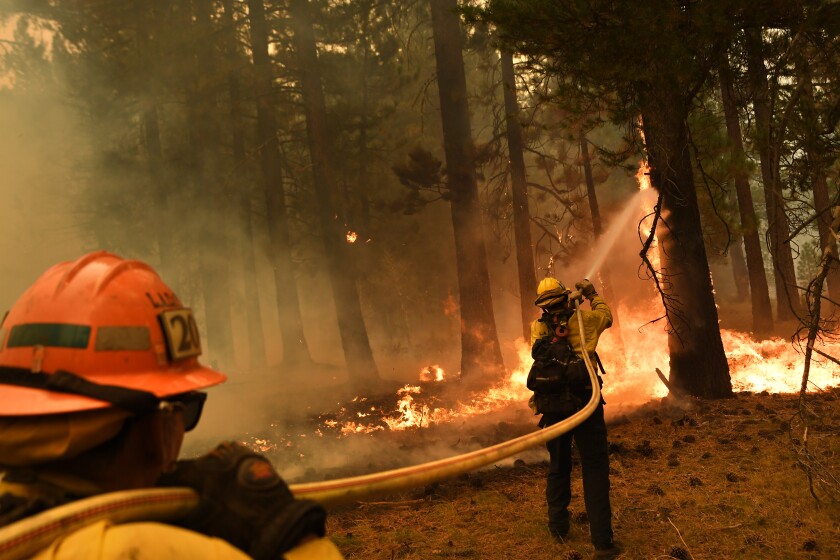The head of the fire is now approaching the California-Nevada state line, spurring concerns that it could involve both states. Firefighters made an all-out effort Tuesday to defend the Lake Tahoe Basin and were able to protect many of the homes in Christmas Valley and Meyers, while also herding the flames into areas south of the popular resort city of South Lake Tahoe.
“We’re fortunate the fire did not make as strong a push into Tahoe as it did the previous day,” Tim Ernst, operations section chief with the California Department of Forestry and Fire Protection, said during a Wednesday morning briefing.
But by midday Wednesday, firefighters were facing strong winds and bone-dry conditions and battling airborne embers and fast-moving flare-ups. Red flag warnings remain in place over much of the fire area until 11 p.m., indicating the potential for wind gusts as strong as 30 mph.
Some experts said the question was not whether the fire would reach the state line but when.
“I’d be surprised if it doesn’t make it to Nevada in the next day or so,” said Craig Clements, a professor of meteorology and director of the Wildfire Interdisciplinary Research Center at San Jose State.
Clements’ team is using dynamic computer modeling to forecast the fire’s likely behavior. The model shows the fire reaching Nevada late Wednesday night or early Thursday morning, he said.
“This is a difficult fire to forecast,” Clements said, noting that, as it burns in complex terrain with very dry vegetation, “fires burn whichever way the wind direction blows.”
Fire incident meteorologist Jim Dudley said earlier Wednesday the “wind regime” that officials saw Tuesday would continue throughout the day.
“Where it was gusty on the ridges, and you saw the swirling erratic wind conditions,” Dudley said, “you’re going to see that again today.”
Strong winds are a major concern for firefighters, as they can send embers aloft and ignite spot fires as far as a mile away, officials said.
Fire behavior analyst Steven Volmer said, given the hot, dry conditions in the area, the probability of an errant ember sparking a new fire was “extremely high” — above 90%. And when fires do start, they can spread at speeds of 200 feet per minute between the crowns of trees, and about 100 feet per minute on the ground, he said.
Beyond the wind, firefighters are also dealing with another challenge, officials said: fatigue. The fire has been burning for 18 days. As of Wednesday morning, it had seared through 204,390 acres and was 20% contained.
“Whether you have been here for the duration of this incident, you came from another fire or you’ve been covering at home, fatigue can and will set in,” one safety officer told firefighters, noting that “we all know we still have a long grind ahead of us.”
The eastern flank of the fire is among the top concerns, officials said, and there was also talk that the fire could head south toward the community of Markleeville in the coming days.
Containment lines made with bulldozers near the Heavenly ski resort appear to be keeping the fire at bay, although flames remain active on the ridge above Kirkwood and in Wrights Lake north of U.S. 50.
The original part of the fire — near Grizzly Flats to the west — is still causing problems, although officials hope to lift some of the evacuation orders in that area within the next 48 hours.
Calling it the state’s “No. 1 priority,” Gov. Gavin Newsom said significant resources were being dedicated to the firefight, including fire retardant being dropped by aircraft, helicopters making water drops, and the National Guard deployed to battle the blaze.
Nevada Gov. Steve Sisolak this week declared a state of emergency “in the anticipation of the fire crossing from California into the state of Nevada in the coming days,” his office said.
More than 4,200 personnel have been assigned to fight the fire, officials said.
Evacuation orders have been issued across a wide swath of the area, including South Lake Tahoe and into Nevada’s Douglas County.
Caldor fire information officer Jason Hunter said structure defense remained firefighters’ top priority in the evacuated areas. Nearly 35,000 structures are threatened by the fire.
“There’s a lot of resources in there doing a significant amount of structure protection and line construction with the bulldozers to the south, along Pioneer Trail,” he said. “They’ve done a lot of work in there.”
Echoing the concerns of other officials, he said a lot would depend on Wednesday’s wind.
“We’re still in that red flag warning … so the potential for growth is definitely there. It just depends how these winds actually develop,” he said.
CALIFORNIA
Evacuation orders issued in Nevada as Caldor fire moves toward Lake Tahoe
Source: LA Times

